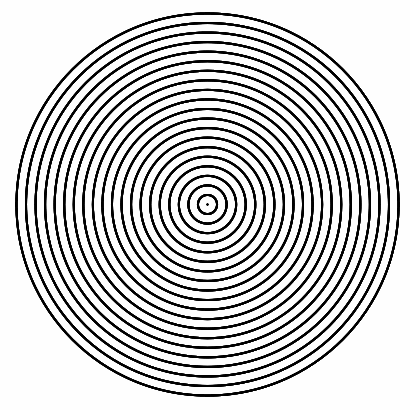Atomization—breaking a liquid into a fine spay of droplets—is common in engines, printers, and in the shower. Here a droplet of water is placed on a thin metal diaphragm that is vibrated at 1 kHz with increasing vibrational amplitude. Capillary waves form on the droplet, and once a critical vibrational amplitude is achieved, tiny droplets are ejected. Full atomization of the original droplet is achieved in about 0.3 seconds real-time. #
Pi Necklace.
Here’s your chance to own an original drawing for under £20!!! This month I’ll be giving away this framed geometric drawing to the person who submits the highest UNIQUE donation UNDER £20. So you could grab yourself a a bargain of a Christmas gift or keep it all to yourself!
DONATE BY 30TH NOVEMBER 2011
Geometric Study: Pencil and silver leaf on paper.
285mm x 385mm (480mm x 580mm inc. frame)
For further details see the following link….. http://alexandracarr.co.uk/Sculpture%20Giveaway.html
3D2REAL
Irregular Honeycomb MDF Structure
The Institute for Lightweight Structures and Conceptual DesignTo catch the eye, steer the gaze, and focus attention. That is the idea behind this exhibition stand, designed and built by five architecture students at the Institute for Lightweight Structures and Conceptual Design (ILEK) under the supervision of Professor Werner Sobek at the University of Stuttgart.
The system serves as a filter between observer and object. The planar elements of the honeycomb-like structure are oriented at specific angles so that only a portion of the area behind the wall is revealed to the viewer. From the outside, only objects that lie within these defined focal points can be seen. Each of the items on display receives its own focal point, according to its size and location. Inside the wall the opposite effect is achieved – the view to the outside from the focal points is completely unobstructed, allowing a panoramic perspective as the honeycomb elements are aligned perpendicular to the observer’s eye.
This numerical simulation shows a von Karman vortex street in the wake of a bluff body. As flow moves over the object, vortices are periodically shed off the object’s upper and lower surfaces at a steady frequency related to the velocity of the flow. The simulation takes place in a channel; note how the thickness of the boundary layers on the walls increases with downstream distance, forcing a slight constriction on the vortex street in the freestream.
hi-res (620 x 1080)
Great open source science stuff →
The solar wind, a rarefied stream of hot plasma ejected from the sun, constantly bombards Earth’s magnetic field. This results in the formation of the magnetosphere, which deflects most of these charged particles away from the earth. Some of them, however, are drawn toward the magnetic poles; when these charged particles strike the upper atmosphere, they cause the gases there to release photons, resulting in the lights we know as auroras. This animation shows the International Space Station flying through the aurora australis—the southern lights. The fluid-like motion of the aurora is no accident; though diffuse, the solar wind is still a fluid governed by magnetohydrodynamics.
15 Pendulums and their waves
via Anna
A Moiré pattern formed with 5 sets of concentric circles.
Code for Mathematica:Manipulate[
Graphics[
{Thickness[.005],
{Table[Circle[{0, 0}, r], {r, 0, 1, .05}],
Table[Circle[{2 t, 0}, r], {r, 0, 1, .05}],
Table[Circle[{-2 t, 0}, r], {r, 0, 1, .05}],
Table[Circle[{0, 2 t}, r], {r, 0, 1, .05}],
Table[Circle[{0, -2 t}, r], {r, 0, 1, .05}]}}],
{t, 0, 1, .05}]
Mapping rhythm patterns and sequences onto space to produce physical data sculptures. 2 dimensional graphic notations which reflect arrangements, intervals and pitch are converted into a 3 dimensional polygonal structure, then fabricated into a physical form.
by Purestform












